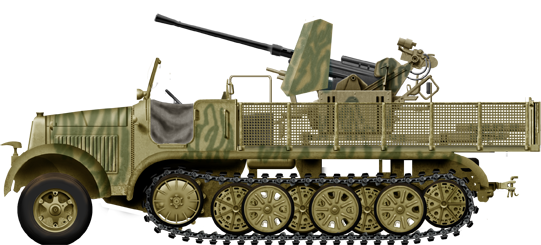 The Sd.Kfz. 6/2 Selbstfahrlafette was a German self-propelled anti-aircraft artillery of WW2. It was based on the Sd.Kfz.6 Zugkraftwagen 5t prime mover and engineers vehicle. It was designed to support Luftwaffe units integrated into armoured divisions, tasked for anti-aircraft protection. 339 were converted, in a process starting in 1941 and completed in 1943. It was eventually replaced by the cheaper and larger Sd.Kfz 7/2.
The Sd.Kfz. 6/2 Selbstfahrlafette was a German self-propelled anti-aircraft artillery of WW2. It was based on the Sd.Kfz.6 Zugkraftwagen 5t prime mover and engineers vehicle. It was designed to support Luftwaffe units integrated into armoured divisions, tasked for anti-aircraft protection. 339 were converted, in a process starting in 1941 and completed in 1943. It was eventually replaced by the cheaper and larger Sd.Kfz 7/2.
About the SdKfz.6
The Development of a new medium artillery tractor started in 1934 and after the prototype developed by Krauss-Maffei, a first serie of eight vehicle started at Büssing-NAG. As designed, it could carry up to 11 men in four rows, or three (9), plus the driver and co-driver. It was aso given a canvas structure and the Sd.Kfz.6 came with the four rows verisions used by enginers (pioneers) while the Sd.Kfz.6/1 sacrificied a row to accomodate a read-round ammunition storage compartment at the back; This was the designated prime mover for the 10.5 leFH 18 howitzer, and oter ordnances.Propulsion wise, it went with a 90 hp, and later 115 hp (67–86 kW) engine through its production, which in 1942 was revised for more simplicity of contruction. The vehicle was indeed quite costly to built. BMM and Mercedes Benz were assocoated to its prpduction to reach 3,640 vehicles total.
This finely engineered half-track truck only reached indeed 750 vehicles until 1942, but the needs of the eastern front pressed for drastically augment the production, ramped up and reorganized in 1943 under Alber Speer. It was carried out Daimler-Benz with BMM and reached more substantial figures. A grand total of 3,500 vehicles has been produced by 1943 when it was halted. The larger and cheaper Sd.Kfz.7 was indeed preferred. It was used on all fronts.
Design of the FLAK 37
Two versions were derived from the basic vehicle: The Sd.Kfz.6/2 (object of the present article) and the 7.62cm Pak-36(r) Auf 5t Zugkraftwagen Sd.Kfz.6/3 also nicknamed "Diana". Only 11 were converted, including the prototype, with a rear enclose armoured body inwhich was installed captured Russian 76.2 mm antitank guns. Only nine saw action, with the Afrika Korps, with the 605 Panzer Abteiling (motorized) in Libya in mid to late 1941. This was an expedient tank hunter able to deal with common allied tanks at the time like the Crusader and earlier Cruiser tanks as the M3 Stuart and M2 Grant when they arrived.As for the FLAK variant it's origins are a bit foggy. The 3.7-cm Flak 36 auf Selbstfahrlafette Sd.Kfz. 6/2 was designed as a self-propelled anti-aircraft gun (called Sd.Kfz 6/2 for short) emerged from a Luftwaffe request to better protect its freshly captured airfields by using a rapidly deployed 3.7 cm autocannon, the standard at the time. In 1940, this gun was seen perfectly able to deal with low-altitude attacks. The 37 mm FLAK with the right ammo as discovered, the APHE could make it a very good improvised anti-tank vehicle if the need arose. It seems production was approved in 1941 and went on until 1943 with a total of 339 (figure generally stated in most sources) actually so converted. So it was far more common than the Sd.Kfz.6/3 by all means.
Protection (or lack thereof)
The 6/2 was based on the artillery half-track version chassis (Sd.Kfz.6/1), on which the body above the flatbed was removed. All two bunk rows and ammunition storage compartment were removed. Unlike other conversions, there was no armour anywhere. Even machine gun fire could disarm the crew. The only protection when present was ensured by the FLAK gun shield, which was optional.The rear flatbed had sides with framed mesh, which could be folded down at 90%, crating a walkable platfom enabling the crew manning the FLAK gun to evolve around. This, this made them completely exposed aside from the gun shield, whe present. The atter was a sloped-two piece plating protecting the face and a bit of side of the gun, at least somewhat protecting from strafing fire from an incoming allied plane, usual the proof against a 0.5 in Browning heavy achine gun fire.
The Sd.Kfz 6/2 was vulnerable on its engine and driver cabin as well as at the edges of the gun shield. A HE or HEAT shell burst could knock out the entire crew in one go. Mobility was less than the basic half-track due to the added weight of the FLAK gun, more like a light/medium tank, but the chassis with the typical rear tracked section enabled still favorable cross-country performance in all seasons and all terrains, essential for the eastern front.
Mobility
Indeed, the base vehicle when equipped with the Maybach NL 54 TUKRUM six-cylinder in-line displacing up to 5.420 liters, had a final output up to 150 hp. The started had a Bosch BJH 1.8/12 magneto and the engine was fed by a carburettor Solex JFF 40. The suspensions comprised the usual directional only forward axle with standard roadwheels and a tracting Schachtellaufwerk (interleaved metal stamped wheels) at the rear, with front drive sprockets and rear wheels acting as tensioners. Top speed on flat went at best to 55 km/h, down to 50 with the 6/2 variant. Radius of action was probably inferior to the regular vehicle (not towing any payload), probably around 280 km on road and 110 off-road.The gun: 3,7 cm FLAK 36

The 3.7 cm Flak 36 (seen here) was part of a famly of three anti-aircraft guns seeing widespread service during the war. Developed in 1935 by Rhheinmetall as the 3.7 cm Flak 18, it was 89 calibers long (L/89) and thus capable of reaching 4,800 m (15,700 ft) in ceiling.
In some cases it was also usable against ground targets, and with the right ammunition from 100 m it could penetrate 36 mm of armour at 60° slope, which was like defeating a light or even medium tank depending of the angle. At 800 m distance it could still defeat 24 mm of armour, making it a very potent last-ditch antitank gun indeed. The base cannon used a mechanical bolt for automatic fire to reach 80 rounds per minute. It was not easy to transport by infantry, at 1,750 kg (3,860 lb) and even reached with its wheeled mount in towed configuration, 3,560 kg (7,850 lb).
The Flak 18 was saw a limited production until 1936, replaced by a new dual-axle mount and lighter single-axle which led to the development of the 3.7 cm Flak 36 (1,550 kg ot 3,420 lb) with the same ballistic characteristics but now 120 rpm. It also had a cheaper, simpler sighting system in 1938, producing the 3.7 cm Flak 37 delivered untl the end of the war. The gun was largely adopted by other axis powers and licence-produced in Romania as the Tun antiaerian Rheinmetall calibru 37 mm model 1939 in Brașov. Production went on until the end of the war in Europe, with 20,243 produced. However by 1944, the 40 mm was looked at a better development caliber.
The gun had a 2.11 m (83 in) 57 calibers barrel, needed a crew of 6 or 7, fired a 37 × 263 mm B shell and rested on a 3-legged platform Carriage with a mount enabling a -8° to +85° elevation and 360° traverse. Muzzle velocity was 770–840 m/s (2,500–2,800 ft/s) for a 4,200 m (4,600 yd) ceiling and 7,995 m (8,743 yd) ground range. Two of the operators (commander, two pointers, two loaders) loaded the breech with 6-round clips.
The gun was adapted to the flatbed of the Sd.Kfz.6/2 in semi-dismountable way, with part of the original trailer dismounted, the legs spread under the platform and fixed on the flatbed by bolting the feets. The two trailer wheels were stored side by side at the rear of the flatbed. A bunk at the front contained ammunition (which was limited, another vehicle was tasked for supplying them), for three seats, and two more were seated on the forward bunk close to the driver. The latter was likely als part of the gun crew.
Combat use of the SdKfz 6/2
As those one-off conversions, the Sd.Kfz. 6/2 Selbstfahrlafette was not a common sight, but it was fore widepsread than its 6/3 cousin which only saw action in North Africa. It is established the vehicle was in service with the Flak Abteilung 75 subordinated under the 12th Panzer Division, as well as the 290th of the 4th PZD, and others. This particular model was produced from 1941 up to 1943 with a total of 339 delivered as per the immatriculations. They only served in organic units of the Lutwaffe attached to the Wehrmacht. They were replaced by the SdKfz 7/2.This model saw action in the Balkans and on the eastern front in 1942-44. There was also an experimental variant in 1945 mounting the new 5cm FLAK, known as the Sd.Kfz.6/2 Selbstfahrlafette mit 5 cm Flak. It only stayed at the prototype stage.
See also:
wardrawings.bealbindenis.free.fr
lonesentry.com
nevingtonwarmuseum.com
nevingtonwarmuseum.com
worldwarphotos.info
perthmilitarymodelling.com kits
wiki de 37 mm PAK 36 auf Sd.Kfz 6/2
Lepage, Jean-Denis (2007). German Military Vehicles of World War II: An Illustrated Guide to Cars, Trucks, Half-Tracks, Motorcycles, Amphibious Vehicles and Others. McFarland.
Bishop, Chris, ed. (1998). The Encyclopedia of Weapons of World War II. Aerospace Publishing.
Popular Mechanics, August 1937 – excellent photo of early Sd.Kfz. 6s on parade
Panzer Tracts and Tank Power books:
Mittlerer Zugkraftwagen 5t (Sd.Kfz.6) & Schwerer Wehrmachtsschlepper: Panzer Tracks No.22-3
Zgkw 5t Sd.Hfz.6 - Tank Power Vol.LVIII
Wydawnictwo Militaria No.287
Sd.Kfz. 6 -5 ton Zugkraftwagen, Büssing - NAG and variants, Nuts & Bolts Volume 39, Nicolaus Hettler
Mittlerer Zugkraftwagen 5t (Sd.Kfz.6) BN 9 Reprint of WWII manual D 606/11
Mittlerer Zugkraftwagen 5tBN 9b Reprint of WWII manual D 606/13
Flak at War Trojca Publications
3.7cm FlaK 36/37 Special Museum Line No.36 Wings & Wheels Publications
Halbketten Zugkraftwagen 8t Sd.Kfz.7/1/2 AFV Super Detail Photo Vol.9 Published by Model Art Co.Ltd.
Büssing-NAG Sd.Kfz.6/2 specifications | |
| Dimensions | 6.325 x 2.2 x 3.5 m (20.75 x 7.2 x 8.1 ft) |
| Total weight, battle ready | 8,500 kg + gun and armor: est. 11 tons |
| Crew | 2 (driver, co-driver) + 4 gun crew |
| Propulsion | Maybach HL54 115 hp (86 kW) |
| Top speed | 50/20 km/h road/off-road |
| Transmission & suspension | 4 + 1 speed ZF - torsion bar |
| Maximum range (on/off road) | 310/150 km (190/90 miles) |
| Armament | 3.7 cm FLAK 36 gun |
| Armor | 6 to 8 mm (0.2-0.3 in) |
| Conversions | 339 |
Gallery

Basic Sd/Kfz.6 carrier
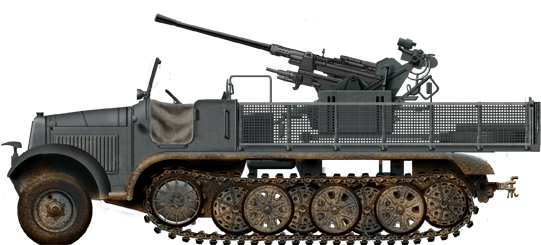
Sd.KFz.6/2 of an unidentified FLAK Abteilung of the Luftwaffe Eastern Front, Summer 1942

Sd.KFz.6/2 of the 290th FLAK Abteilung of the Luftwaffe attached to the 5th Panzerdivision, Eastern Front, Summer 1944
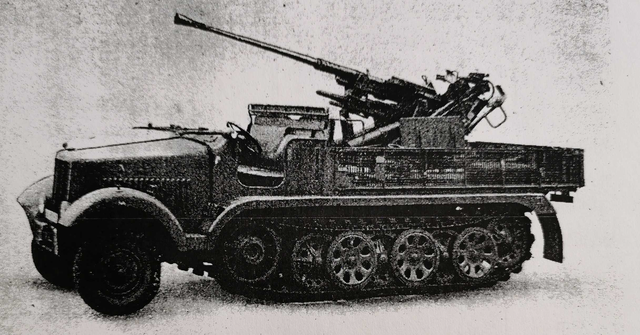
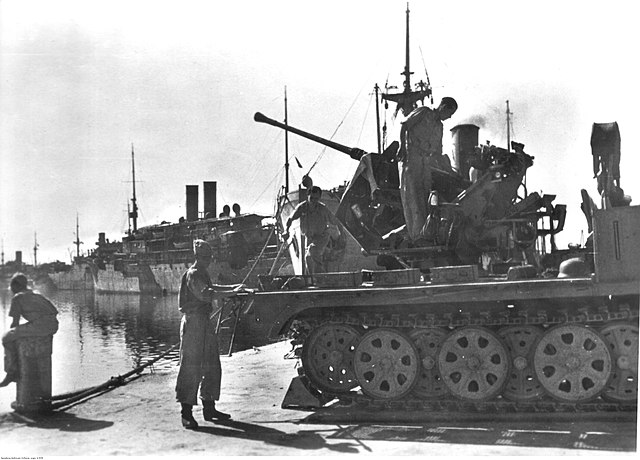
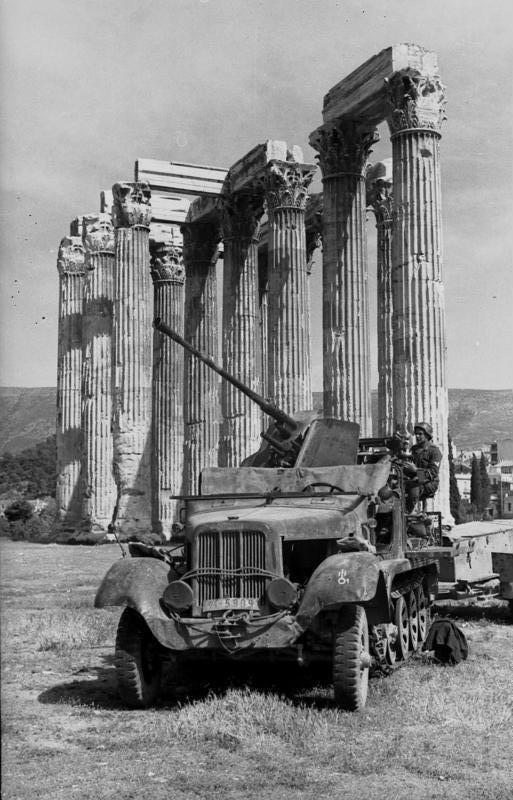
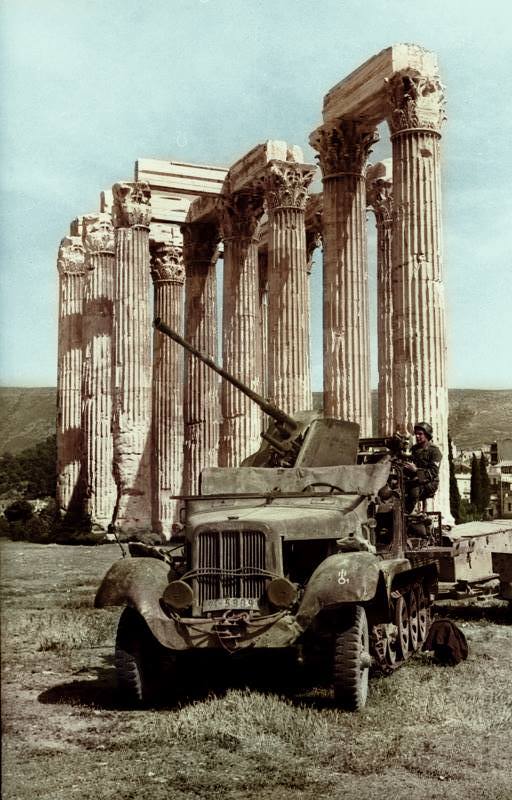
Sd.Kfz.6/2 37cm Flak in Greece, Recolored

Poster: Germans Tanks of ww2

WW2 Tanks




























WW2 tanks posters

All Tiger tanks liveries.

Panther liveries and variants

WW2 Armour - All tanks











Tanks aces and single tanks series

Find more there

Museums, Movies, Books & Games
The Tanks and Armor in pop culture
Tanks and armored vehicles in general are only really grasped when seen first person: The mass, the scale, it's all there. Explore also the way tanks were covered in the movie industry, in books and in video games.Movies:
Best tanks movie on warhistoryonline.com
On imdb.com
On bestsimilar.com/
miltours.com
liveabout.com/
watchmojo.com
Video Games:
pcgamesn.com
historyhit.com
levvvel.com
vg247.com/best-tank-games
mmobomb.com/
alienwarearena.com

